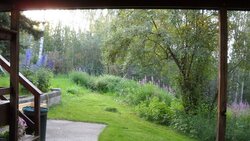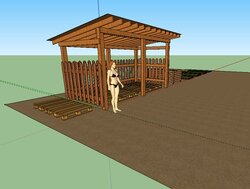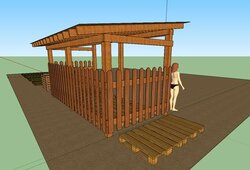Ok now that I've learned that when they sell "seasoned" wood it really only means its not attached to mother earth by roots still.... I'm ready to start "aging" my wood for future years. I wanted to build a wood shed that looked good as opposed to a drunken looking pile that I made last year (have not perfected the art of a nice looking wood pile and admire those I see) with an ugly plastic cover in it that makes it look like the Beverly Hillbillies moved to NH (add my pile of pallets I've collected and I really just need a few junk cars to have some peoples version of paradise!
So I've read the pro's and con's of having a cover and have decided I want some sort of covering (though still welcome to comments re total open air aging. I'm envisioning a 16 ft long, 4 ft wide structure (lowes has 2x6 x 16 ft for $9.99) and I would have the front 8 ft tall sloping down to 5 ft in the rear giving me room for 4 cords plus some kindling. I want to use this clear plastic corrugated roof panels from Lowes for the roof and will have it south facing (the sloped panels) and figure the sun will help "cook the wood with some greenhouse effect. How's it sound so far? Then I was thinking to I want to also use those Panels (see below) to cover the back (vertical part) and the sides to help with more solar heating and put a couple of those solar powered fans I've used in boats over the years to keep the air moving. (see pic below also) Too high tech? By using the panels and fans could I shave any appreciable time off getting the moisture out of this wood or should I KISS (keep it simple stupid)
Comments appreciated


So I've read the pro's and con's of having a cover and have decided I want some sort of covering (though still welcome to comments re total open air aging. I'm envisioning a 16 ft long, 4 ft wide structure (lowes has 2x6 x 16 ft for $9.99) and I would have the front 8 ft tall sloping down to 5 ft in the rear giving me room for 4 cords plus some kindling. I want to use this clear plastic corrugated roof panels from Lowes for the roof and will have it south facing (the sloped panels) and figure the sun will help "cook the wood with some greenhouse effect. How's it sound so far? Then I was thinking to I want to also use those Panels (see below) to cover the back (vertical part) and the sides to help with more solar heating and put a couple of those solar powered fans I've used in boats over the years to keep the air moving. (see pic below also) Too high tech? By using the panels and fans could I shave any appreciable time off getting the moisture out of this wood or should I KISS (keep it simple stupid)
Comments appreciated








